International Marketing Strategies for M&S: A Detailed Report
VerifiedAdded on 2020/06/06
|23
|8106
|25
Report
AI Summary
This report provides a comprehensive analysis of Marks and Spencer's (M&S) international marketing management. It begins with an introduction to international marketing and its importance for the organization, followed by an examination of the need for international marketing and the benefits it offers, such as increased revenue and diversification. The report then delves into the elements of the marketing concept, including situational analysis, marketing strategy, and marketing mix decisions. A PESTLE analysis is conducted to assess the political, economic, social, technological, legal, and environmental factors affecting M&S in foreign markets. The report also explores different market entry strategies, channels of distribution, and the role of the marketing mix in sustaining competitive advantage, including a comparison between the marketing mix and the extended marketing mix. The report concludes with an overview of the objectives of international marketing and the importance of adapting to changing market trends and customer needs. This report is a valuable resource for students studying international marketing, providing insights into the challenges and opportunities faced by multinational retailers like M&S.
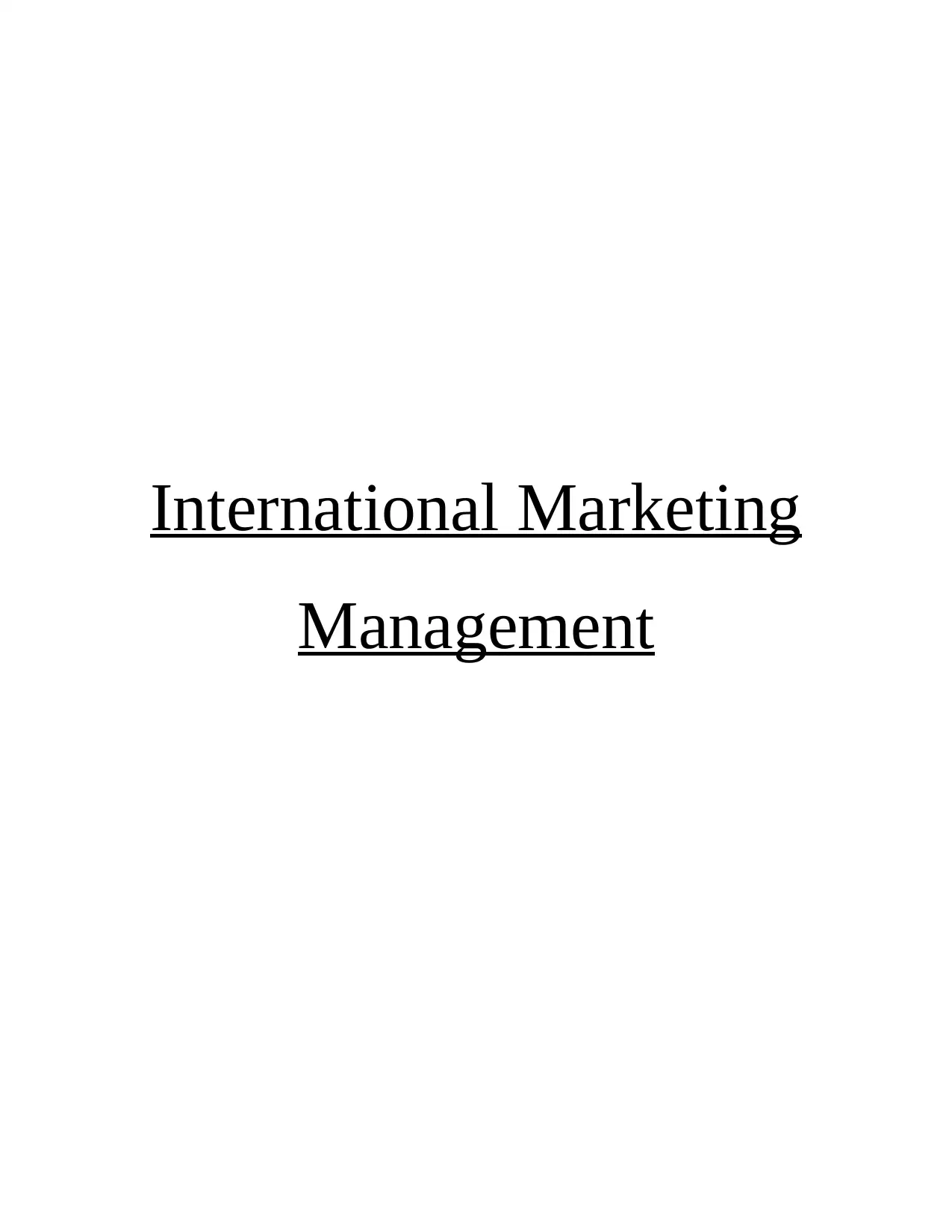
International Marketing
Management
Management
Paraphrase This Document
Need a fresh take? Get an instant paraphrase of this document with our AI Paraphraser
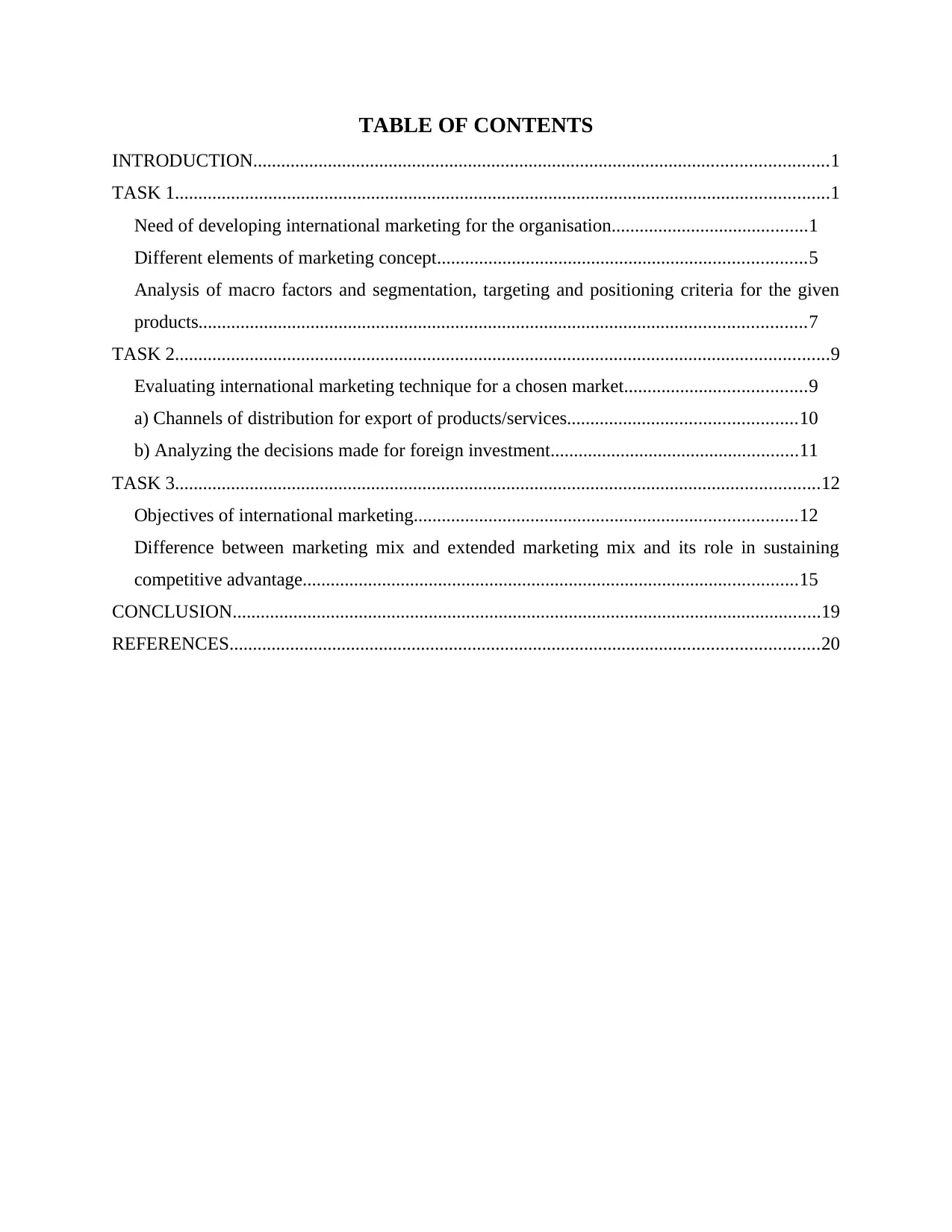
TABLE OF CONTENTS
INTRODUCTION...........................................................................................................................1
TASK 1............................................................................................................................................1
Need of developing international marketing for the organisation..........................................1
Different elements of marketing concept...............................................................................5
Analysis of macro factors and segmentation, targeting and positioning criteria for the given
products..................................................................................................................................7
TASK 2............................................................................................................................................9
Evaluating international marketing technique for a chosen market.......................................9
a) Channels of distribution for export of products/services.................................................10
b) Analyzing the decisions made for foreign investment.....................................................11
TASK 3..........................................................................................................................................12
Objectives of international marketing..................................................................................12
Difference between marketing mix and extended marketing mix and its role in sustaining
competitive advantage..........................................................................................................15
CONCLUSION..............................................................................................................................19
REFERENCES..............................................................................................................................20
INTRODUCTION...........................................................................................................................1
TASK 1............................................................................................................................................1
Need of developing international marketing for the organisation..........................................1
Different elements of marketing concept...............................................................................5
Analysis of macro factors and segmentation, targeting and positioning criteria for the given
products..................................................................................................................................7
TASK 2............................................................................................................................................9
Evaluating international marketing technique for a chosen market.......................................9
a) Channels of distribution for export of products/services.................................................10
b) Analyzing the decisions made for foreign investment.....................................................11
TASK 3..........................................................................................................................................12
Objectives of international marketing..................................................................................12
Difference between marketing mix and extended marketing mix and its role in sustaining
competitive advantage..........................................................................................................15
CONCLUSION..............................................................................................................................19
REFERENCES..............................................................................................................................20
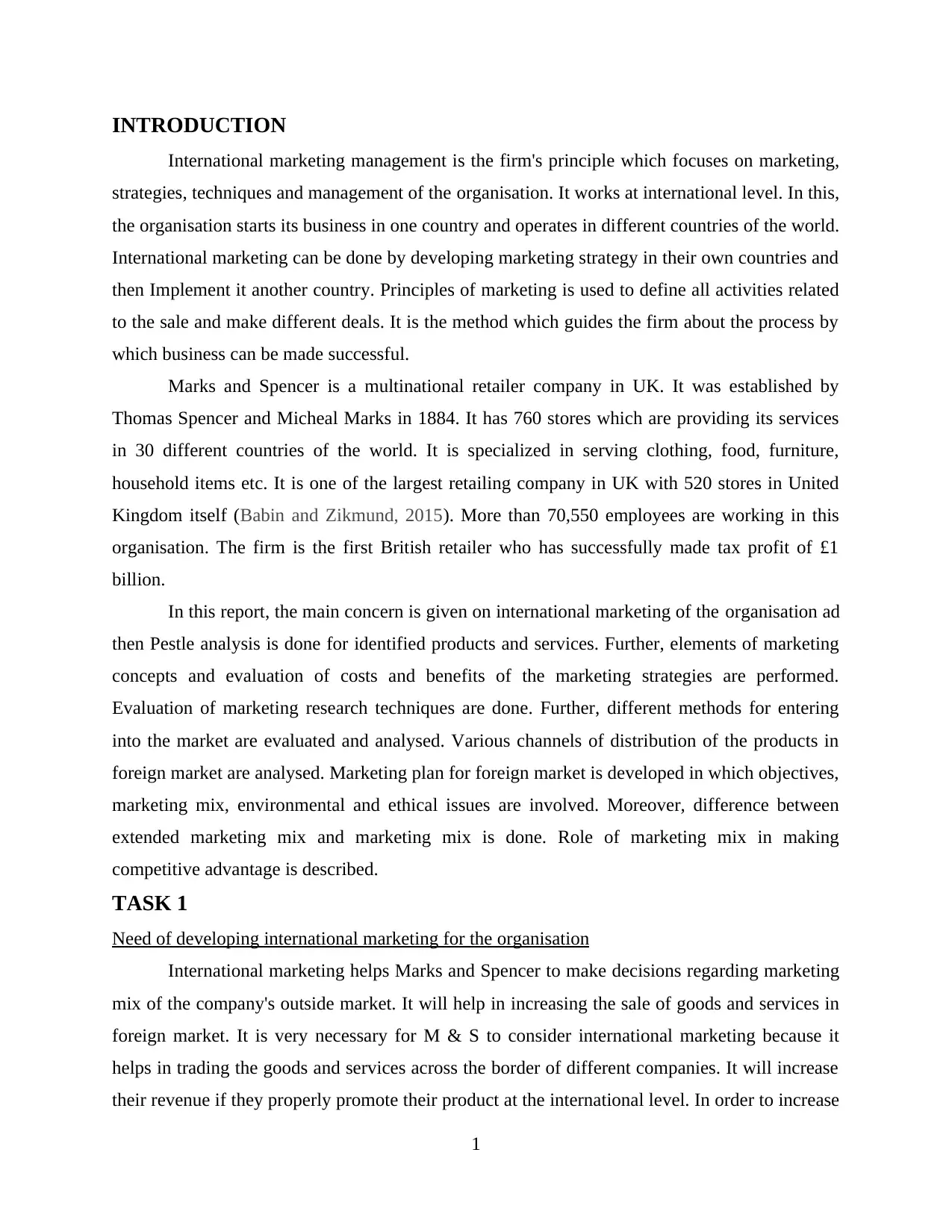
INTRODUCTION
International marketing management is the firm's principle which focuses on marketing,
strategies, techniques and management of the organisation. It works at international level. In this,
the organisation starts its business in one country and operates in different countries of the world.
International marketing can be done by developing marketing strategy in their own countries and
then Implement it another country. Principles of marketing is used to define all activities related
to the sale and make different deals. It is the method which guides the firm about the process by
which business can be made successful.
Marks and Spencer is a multinational retailer company in UK. It was established by
Thomas Spencer and Micheal Marks in 1884. It has 760 stores which are providing its services
in 30 different countries of the world. It is specialized in serving clothing, food, furniture,
household items etc. It is one of the largest retailing company in UK with 520 stores in United
Kingdom itself (Babin and Zikmund, 2015). More than 70,550 employees are working in this
organisation. The firm is the first British retailer who has successfully made tax profit of £1
billion.
In this report, the main concern is given on international marketing of the organisation ad
then Pestle analysis is done for identified products and services. Further, elements of marketing
concepts and evaluation of costs and benefits of the marketing strategies are performed.
Evaluation of marketing research techniques are done. Further, different methods for entering
into the market are evaluated and analysed. Various channels of distribution of the products in
foreign market are analysed. Marketing plan for foreign market is developed in which objectives,
marketing mix, environmental and ethical issues are involved. Moreover, difference between
extended marketing mix and marketing mix is done. Role of marketing mix in making
competitive advantage is described.
TASK 1
Need of developing international marketing for the organisation
International marketing helps Marks and Spencer to make decisions regarding marketing
mix of the company's outside market. It will help in increasing the sale of goods and services in
foreign market. It is very necessary for M & S to consider international marketing because it
helps in trading the goods and services across the border of different companies. It will increase
their revenue if they properly promote their product at the international level. In order to increase
1
International marketing management is the firm's principle which focuses on marketing,
strategies, techniques and management of the organisation. It works at international level. In this,
the organisation starts its business in one country and operates in different countries of the world.
International marketing can be done by developing marketing strategy in their own countries and
then Implement it another country. Principles of marketing is used to define all activities related
to the sale and make different deals. It is the method which guides the firm about the process by
which business can be made successful.
Marks and Spencer is a multinational retailer company in UK. It was established by
Thomas Spencer and Micheal Marks in 1884. It has 760 stores which are providing its services
in 30 different countries of the world. It is specialized in serving clothing, food, furniture,
household items etc. It is one of the largest retailing company in UK with 520 stores in United
Kingdom itself (Babin and Zikmund, 2015). More than 70,550 employees are working in this
organisation. The firm is the first British retailer who has successfully made tax profit of £1
billion.
In this report, the main concern is given on international marketing of the organisation ad
then Pestle analysis is done for identified products and services. Further, elements of marketing
concepts and evaluation of costs and benefits of the marketing strategies are performed.
Evaluation of marketing research techniques are done. Further, different methods for entering
into the market are evaluated and analysed. Various channels of distribution of the products in
foreign market are analysed. Marketing plan for foreign market is developed in which objectives,
marketing mix, environmental and ethical issues are involved. Moreover, difference between
extended marketing mix and marketing mix is done. Role of marketing mix in making
competitive advantage is described.
TASK 1
Need of developing international marketing for the organisation
International marketing helps Marks and Spencer to make decisions regarding marketing
mix of the company's outside market. It will help in increasing the sale of goods and services in
foreign market. It is very necessary for M & S to consider international marketing because it
helps in trading the goods and services across the border of different companies. It will increase
their revenue if they properly promote their product at the international level. In order to increase
1
⊘ This is a preview!⊘
Do you want full access?
Subscribe today to unlock all pages.

Trusted by 1+ million students worldwide
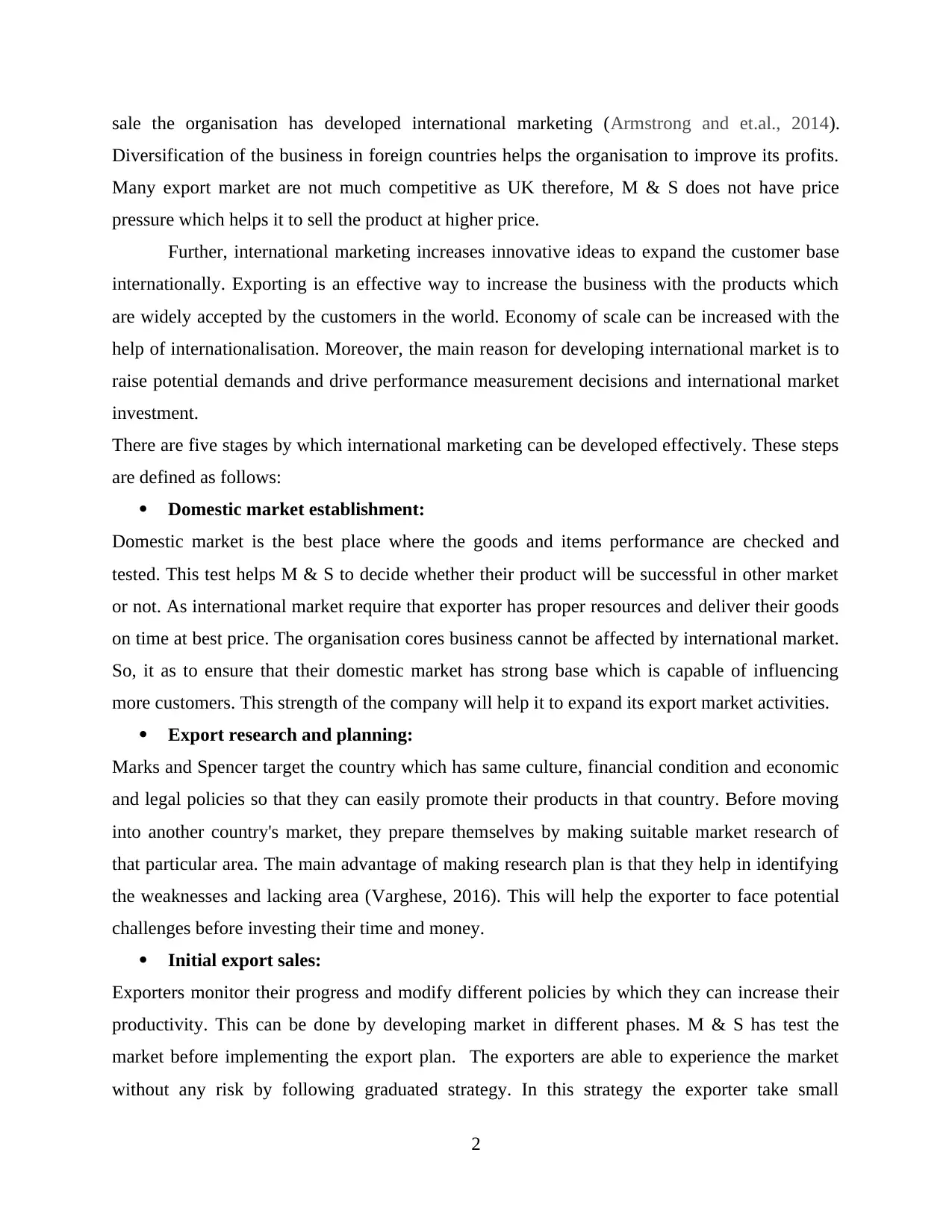
sale the organisation has developed international marketing (Armstrong and et.al., 2014).
Diversification of the business in foreign countries helps the organisation to improve its profits.
Many export market are not much competitive as UK therefore, M & S does not have price
pressure which helps it to sell the product at higher price.
Further, international marketing increases innovative ideas to expand the customer base
internationally. Exporting is an effective way to increase the business with the products which
are widely accepted by the customers in the world. Economy of scale can be increased with the
help of internationalisation. Moreover, the main reason for developing international market is to
raise potential demands and drive performance measurement decisions and international market
investment.
There are five stages by which international marketing can be developed effectively. These steps
are defined as follows:
Domestic market establishment:
Domestic market is the best place where the goods and items performance are checked and
tested. This test helps M & S to decide whether their product will be successful in other market
or not. As international market require that exporter has proper resources and deliver their goods
on time at best price. The organisation cores business cannot be affected by international market.
So, it as to ensure that their domestic market has strong base which is capable of influencing
more customers. This strength of the company will help it to expand its export market activities.
Export research and planning:
Marks and Spencer target the country which has same culture, financial condition and economic
and legal policies so that they can easily promote their products in that country. Before moving
into another country's market, they prepare themselves by making suitable market research of
that particular area. The main advantage of making research plan is that they help in identifying
the weaknesses and lacking area (Varghese, 2016). This will help the exporter to face potential
challenges before investing their time and money.
Initial export sales:
Exporters monitor their progress and modify different policies by which they can increase their
productivity. This can be done by developing market in different phases. M & S has test the
market before implementing the export plan. The exporters are able to experience the market
without any risk by following graduated strategy. In this strategy the exporter take small
2
Diversification of the business in foreign countries helps the organisation to improve its profits.
Many export market are not much competitive as UK therefore, M & S does not have price
pressure which helps it to sell the product at higher price.
Further, international marketing increases innovative ideas to expand the customer base
internationally. Exporting is an effective way to increase the business with the products which
are widely accepted by the customers in the world. Economy of scale can be increased with the
help of internationalisation. Moreover, the main reason for developing international market is to
raise potential demands and drive performance measurement decisions and international market
investment.
There are five stages by which international marketing can be developed effectively. These steps
are defined as follows:
Domestic market establishment:
Domestic market is the best place where the goods and items performance are checked and
tested. This test helps M & S to decide whether their product will be successful in other market
or not. As international market require that exporter has proper resources and deliver their goods
on time at best price. The organisation cores business cannot be affected by international market.
So, it as to ensure that their domestic market has strong base which is capable of influencing
more customers. This strength of the company will help it to expand its export market activities.
Export research and planning:
Marks and Spencer target the country which has same culture, financial condition and economic
and legal policies so that they can easily promote their products in that country. Before moving
into another country's market, they prepare themselves by making suitable market research of
that particular area. The main advantage of making research plan is that they help in identifying
the weaknesses and lacking area (Varghese, 2016). This will help the exporter to face potential
challenges before investing their time and money.
Initial export sales:
Exporters monitor their progress and modify different policies by which they can increase their
productivity. This can be done by developing market in different phases. M & S has test the
market before implementing the export plan. The exporters are able to experience the market
without any risk by following graduated strategy. In this strategy the exporter take small
2
Paraphrase This Document
Need a fresh take? Get an instant paraphrase of this document with our AI Paraphraser
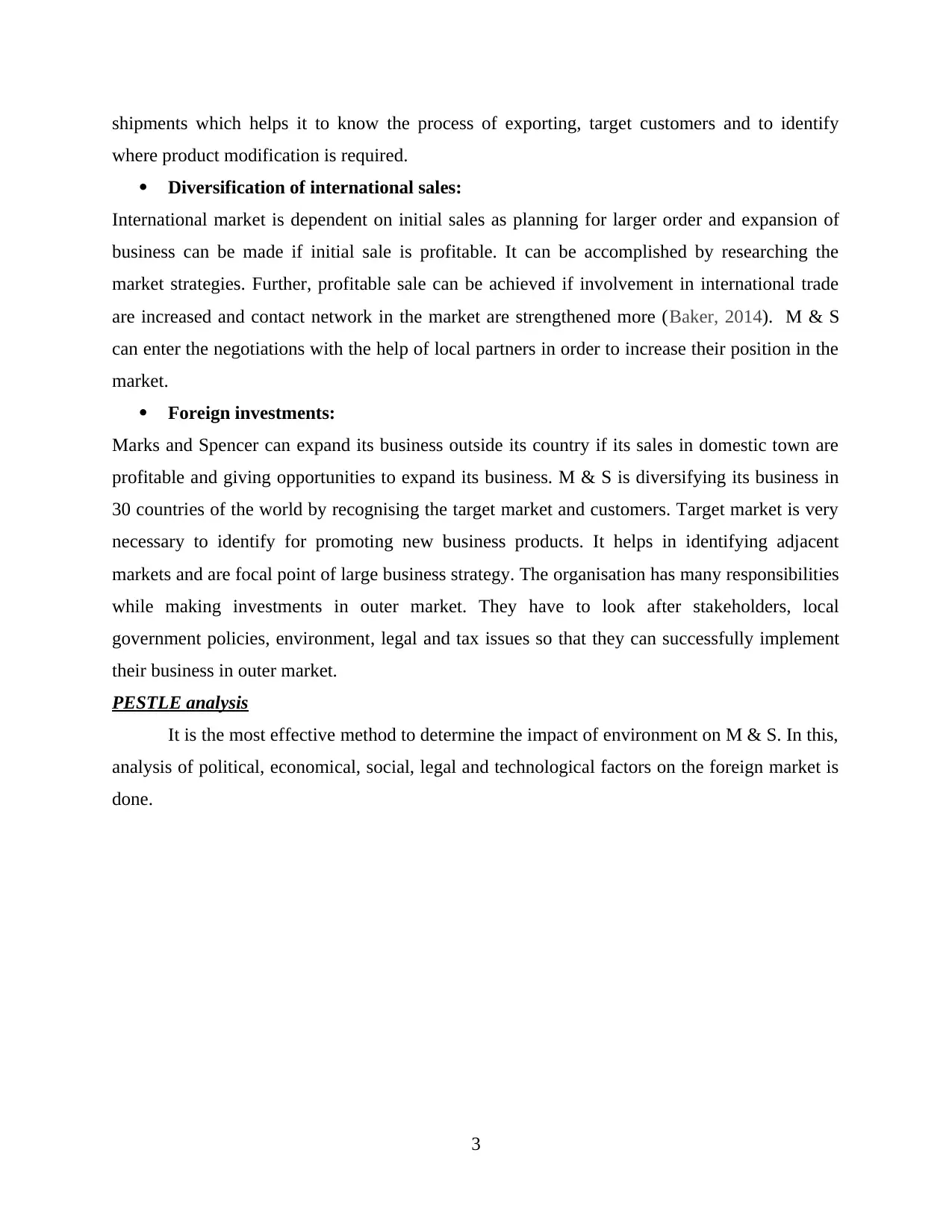
shipments which helps it to know the process of exporting, target customers and to identify
where product modification is required.
Diversification of international sales:
International market is dependent on initial sales as planning for larger order and expansion of
business can be made if initial sale is profitable. It can be accomplished by researching the
market strategies. Further, profitable sale can be achieved if involvement in international trade
are increased and contact network in the market are strengthened more (Baker, 2014). M & S
can enter the negotiations with the help of local partners in order to increase their position in the
market.
Foreign investments:
Marks and Spencer can expand its business outside its country if its sales in domestic town are
profitable and giving opportunities to expand its business. M & S is diversifying its business in
30 countries of the world by recognising the target market and customers. Target market is very
necessary to identify for promoting new business products. It helps in identifying adjacent
markets and are focal point of large business strategy. The organisation has many responsibilities
while making investments in outer market. They have to look after stakeholders, local
government policies, environment, legal and tax issues so that they can successfully implement
their business in outer market.
PESTLE analysis
It is the most effective method to determine the impact of environment on M & S. In this,
analysis of political, economical, social, legal and technological factors on the foreign market is
done.
3
where product modification is required.
Diversification of international sales:
International market is dependent on initial sales as planning for larger order and expansion of
business can be made if initial sale is profitable. It can be accomplished by researching the
market strategies. Further, profitable sale can be achieved if involvement in international trade
are increased and contact network in the market are strengthened more (Baker, 2014). M & S
can enter the negotiations with the help of local partners in order to increase their position in the
market.
Foreign investments:
Marks and Spencer can expand its business outside its country if its sales in domestic town are
profitable and giving opportunities to expand its business. M & S is diversifying its business in
30 countries of the world by recognising the target market and customers. Target market is very
necessary to identify for promoting new business products. It helps in identifying adjacent
markets and are focal point of large business strategy. The organisation has many responsibilities
while making investments in outer market. They have to look after stakeholders, local
government policies, environment, legal and tax issues so that they can successfully implement
their business in outer market.
PESTLE analysis
It is the most effective method to determine the impact of environment on M & S. In this,
analysis of political, economical, social, legal and technological factors on the foreign market is
done.
3
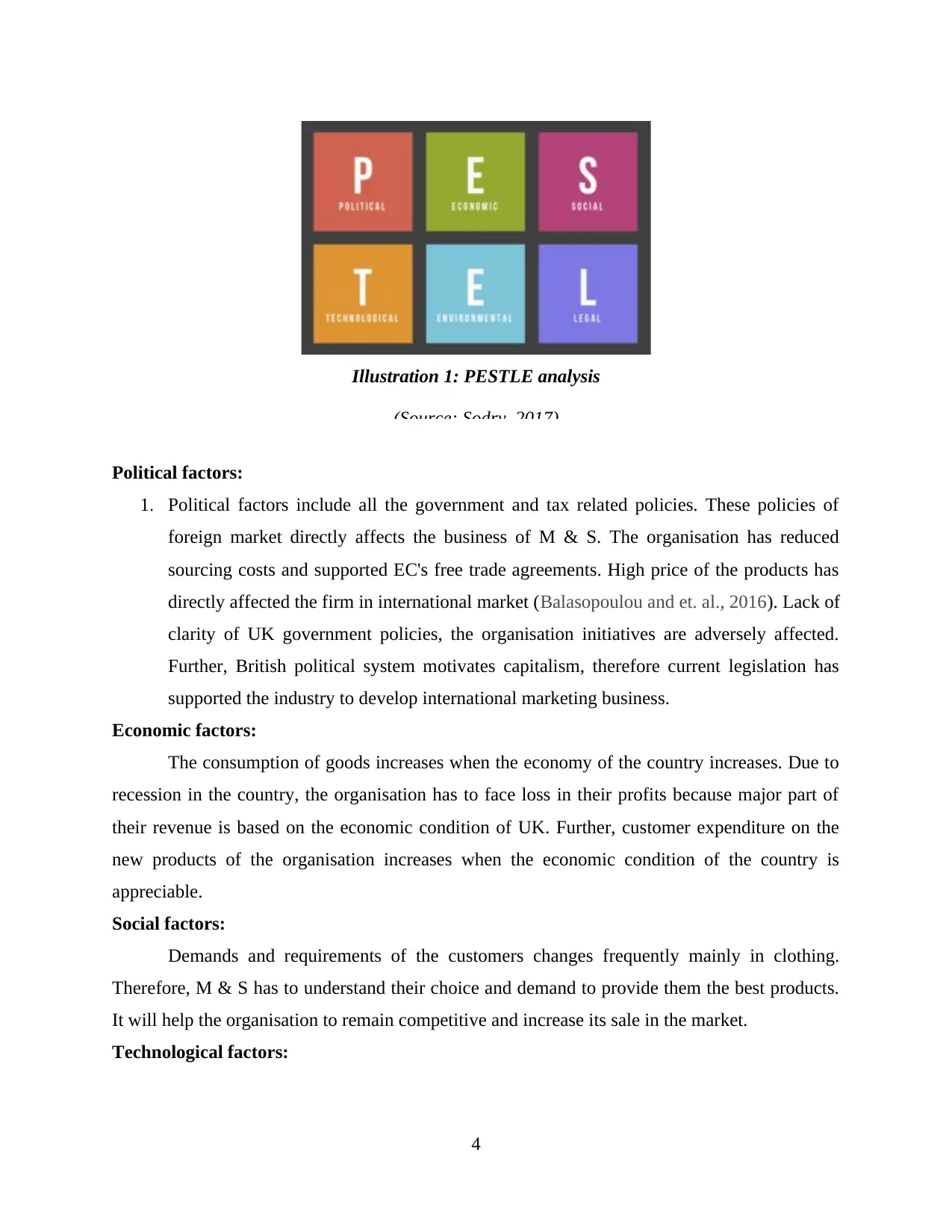
Political factors:
1. Political factors include all the government and tax related policies. These policies of
foreign market directly affects the business of M & S. The organisation has reduced
sourcing costs and supported EC's free trade agreements. High price of the products has
directly affected the firm in international market (Balasopoulou and et. al., 2016). Lack of
clarity of UK government policies, the organisation initiatives are adversely affected.
Further, British political system motivates capitalism, therefore current legislation has
supported the industry to develop international marketing business.
Economic factors:
The consumption of goods increases when the economy of the country increases. Due to
recession in the country, the organisation has to face loss in their profits because major part of
their revenue is based on the economic condition of UK. Further, customer expenditure on the
new products of the organisation increases when the economic condition of the country is
appreciable.
Social factors:
Demands and requirements of the customers changes frequently mainly in clothing.
Therefore, M & S has to understand their choice and demand to provide them the best products.
It will help the organisation to remain competitive and increase its sale in the market.
Technological factors:
4
Illustration 1: PESTLE analysis
(Source: Sodry, 2017)
1. Political factors include all the government and tax related policies. These policies of
foreign market directly affects the business of M & S. The organisation has reduced
sourcing costs and supported EC's free trade agreements. High price of the products has
directly affected the firm in international market (Balasopoulou and et. al., 2016). Lack of
clarity of UK government policies, the organisation initiatives are adversely affected.
Further, British political system motivates capitalism, therefore current legislation has
supported the industry to develop international marketing business.
Economic factors:
The consumption of goods increases when the economy of the country increases. Due to
recession in the country, the organisation has to face loss in their profits because major part of
their revenue is based on the economic condition of UK. Further, customer expenditure on the
new products of the organisation increases when the economic condition of the country is
appreciable.
Social factors:
Demands and requirements of the customers changes frequently mainly in clothing.
Therefore, M & S has to understand their choice and demand to provide them the best products.
It will help the organisation to remain competitive and increase its sale in the market.
Technological factors:
4
Illustration 1: PESTLE analysis
(Source: Sodry, 2017)
⊘ This is a preview!⊘
Do you want full access?
Subscribe today to unlock all pages.

Trusted by 1+ million students worldwide
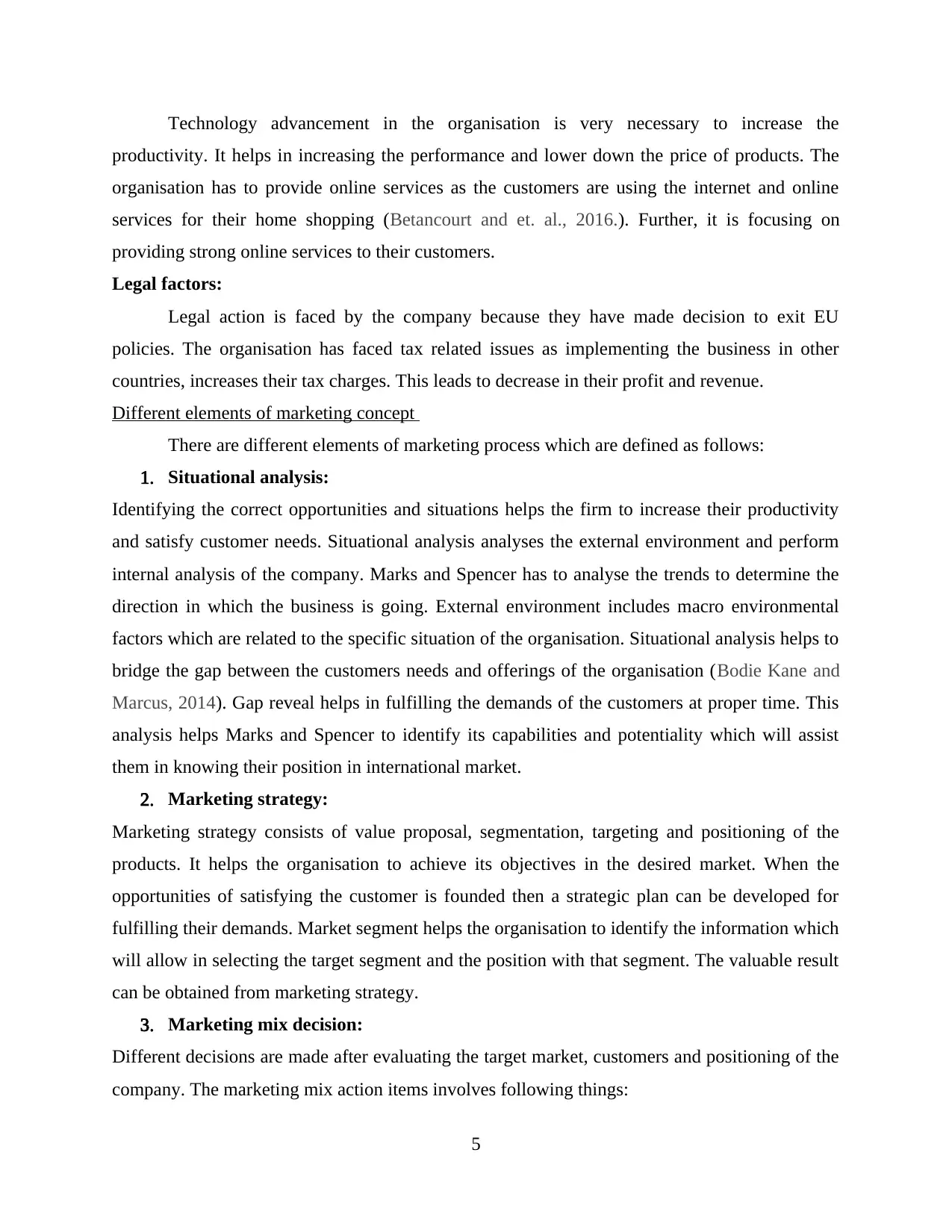
Technology advancement in the organisation is very necessary to increase the
productivity. It helps in increasing the performance and lower down the price of products. The
organisation has to provide online services as the customers are using the internet and online
services for their home shopping (Betancourt and et. al., 2016.). Further, it is focusing on
providing strong online services to their customers.
Legal factors:
Legal action is faced by the company because they have made decision to exit EU
policies. The organisation has faced tax related issues as implementing the business in other
countries, increases their tax charges. This leads to decrease in their profit and revenue.
Different elements of marketing concept
There are different elements of marketing process which are defined as follows:
1. Situational analysis:
Identifying the correct opportunities and situations helps the firm to increase their productivity
and satisfy customer needs. Situational analysis analyses the external environment and perform
internal analysis of the company. Marks and Spencer has to analyse the trends to determine the
direction in which the business is going. External environment includes macro environmental
factors which are related to the specific situation of the organisation. Situational analysis helps to
bridge the gap between the customers needs and offerings of the organisation (Bodie Kane and
Marcus, 2014). Gap reveal helps in fulfilling the demands of the customers at proper time. This
analysis helps Marks and Spencer to identify its capabilities and potentiality which will assist
them in knowing their position in international market.
2. Marketing strategy:
Marketing strategy consists of value proposal, segmentation, targeting and positioning of the
products. It helps the organisation to achieve its objectives in the desired market. When the
opportunities of satisfying the customer is founded then a strategic plan can be developed for
fulfilling their demands. Market segment helps the organisation to identify the information which
will allow in selecting the target segment and the position with that segment. The valuable result
can be obtained from marketing strategy.
3. Marketing mix decision:
Different decisions are made after evaluating the target market, customers and positioning of the
company. The marketing mix action items involves following things:
5
productivity. It helps in increasing the performance and lower down the price of products. The
organisation has to provide online services as the customers are using the internet and online
services for their home shopping (Betancourt and et. al., 2016.). Further, it is focusing on
providing strong online services to their customers.
Legal factors:
Legal action is faced by the company because they have made decision to exit EU
policies. The organisation has faced tax related issues as implementing the business in other
countries, increases their tax charges. This leads to decrease in their profit and revenue.
Different elements of marketing concept
There are different elements of marketing process which are defined as follows:
1. Situational analysis:
Identifying the correct opportunities and situations helps the firm to increase their productivity
and satisfy customer needs. Situational analysis analyses the external environment and perform
internal analysis of the company. Marks and Spencer has to analyse the trends to determine the
direction in which the business is going. External environment includes macro environmental
factors which are related to the specific situation of the organisation. Situational analysis helps to
bridge the gap between the customers needs and offerings of the organisation (Bodie Kane and
Marcus, 2014). Gap reveal helps in fulfilling the demands of the customers at proper time. This
analysis helps Marks and Spencer to identify its capabilities and potentiality which will assist
them in knowing their position in international market.
2. Marketing strategy:
Marketing strategy consists of value proposal, segmentation, targeting and positioning of the
products. It helps the organisation to achieve its objectives in the desired market. When the
opportunities of satisfying the customer is founded then a strategic plan can be developed for
fulfilling their demands. Market segment helps the organisation to identify the information which
will allow in selecting the target segment and the position with that segment. The valuable result
can be obtained from marketing strategy.
3. Marketing mix decision:
Different decisions are made after evaluating the target market, customers and positioning of the
company. The marketing mix action items involves following things:
5
Paraphrase This Document
Need a fresh take? Get an instant paraphrase of this document with our AI Paraphraser
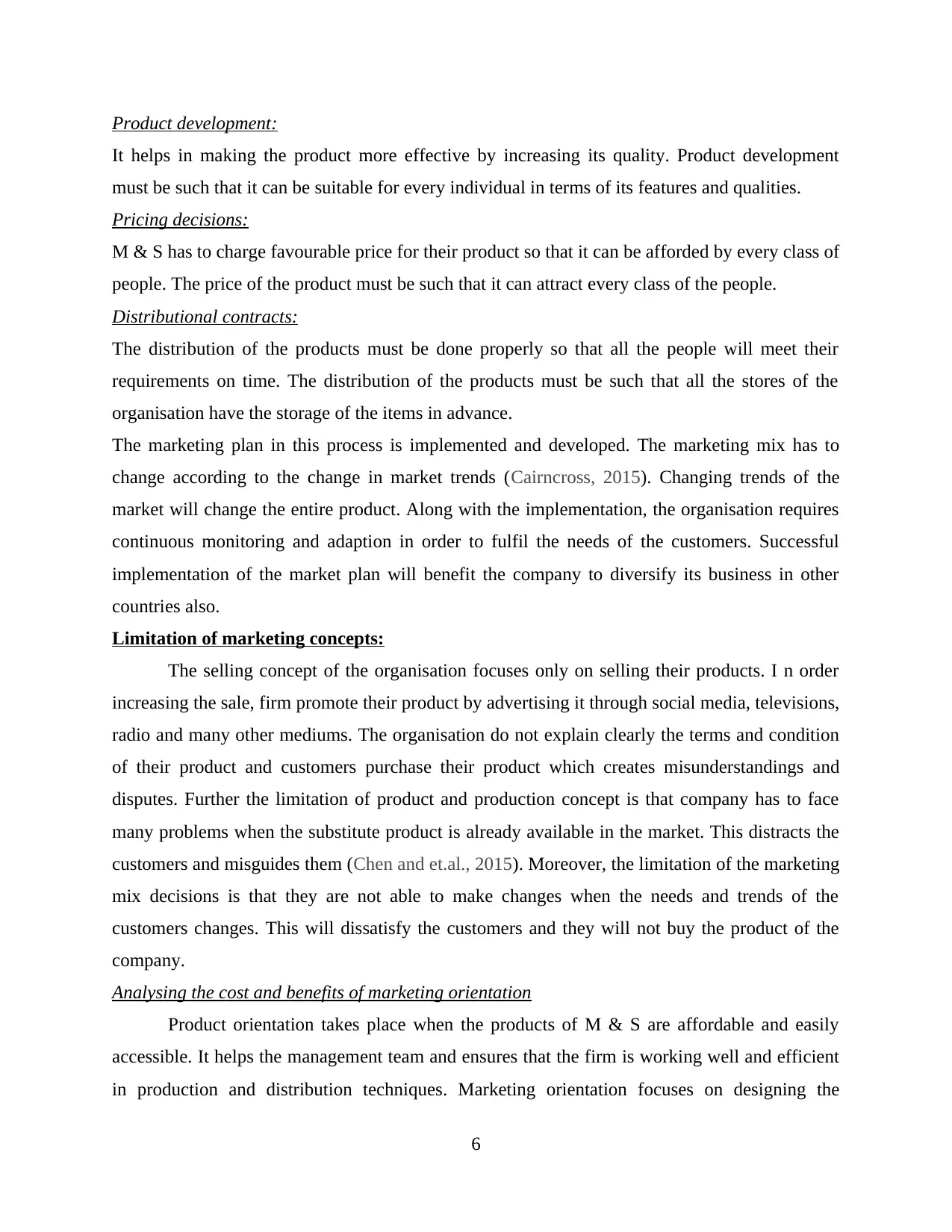
Product development:
It helps in making the product more effective by increasing its quality. Product development
must be such that it can be suitable for every individual in terms of its features and qualities.
Pricing decisions:
M & S has to charge favourable price for their product so that it can be afforded by every class of
people. The price of the product must be such that it can attract every class of the people.
Distributional contracts:
The distribution of the products must be done properly so that all the people will meet their
requirements on time. The distribution of the products must be such that all the stores of the
organisation have the storage of the items in advance.
The marketing plan in this process is implemented and developed. The marketing mix has to
change according to the change in market trends (Cairncross, 2015). Changing trends of the
market will change the entire product. Along with the implementation, the organisation requires
continuous monitoring and adaption in order to fulfil the needs of the customers. Successful
implementation of the market plan will benefit the company to diversify its business in other
countries also.
Limitation of marketing concepts:
The selling concept of the organisation focuses only on selling their products. I n order
increasing the sale, firm promote their product by advertising it through social media, televisions,
radio and many other mediums. The organisation do not explain clearly the terms and condition
of their product and customers purchase their product which creates misunderstandings and
disputes. Further the limitation of product and production concept is that company has to face
many problems when the substitute product is already available in the market. This distracts the
customers and misguides them (Chen and et.al., 2015). Moreover, the limitation of the marketing
mix decisions is that they are not able to make changes when the needs and trends of the
customers changes. This will dissatisfy the customers and they will not buy the product of the
company.
Analysing the cost and benefits of marketing orientation
Product orientation takes place when the products of M & S are affordable and easily
accessible. It helps the management team and ensures that the firm is working well and efficient
in production and distribution techniques. Marketing orientation focuses on designing the
6
It helps in making the product more effective by increasing its quality. Product development
must be such that it can be suitable for every individual in terms of its features and qualities.
Pricing decisions:
M & S has to charge favourable price for their product so that it can be afforded by every class of
people. The price of the product must be such that it can attract every class of the people.
Distributional contracts:
The distribution of the products must be done properly so that all the people will meet their
requirements on time. The distribution of the products must be such that all the stores of the
organisation have the storage of the items in advance.
The marketing plan in this process is implemented and developed. The marketing mix has to
change according to the change in market trends (Cairncross, 2015). Changing trends of the
market will change the entire product. Along with the implementation, the organisation requires
continuous monitoring and adaption in order to fulfil the needs of the customers. Successful
implementation of the market plan will benefit the company to diversify its business in other
countries also.
Limitation of marketing concepts:
The selling concept of the organisation focuses only on selling their products. I n order
increasing the sale, firm promote their product by advertising it through social media, televisions,
radio and many other mediums. The organisation do not explain clearly the terms and condition
of their product and customers purchase their product which creates misunderstandings and
disputes. Further the limitation of product and production concept is that company has to face
many problems when the substitute product is already available in the market. This distracts the
customers and misguides them (Chen and et.al., 2015). Moreover, the limitation of the marketing
mix decisions is that they are not able to make changes when the needs and trends of the
customers changes. This will dissatisfy the customers and they will not buy the product of the
company.
Analysing the cost and benefits of marketing orientation
Product orientation takes place when the products of M & S are affordable and easily
accessible. It helps the management team and ensures that the firm is working well and efficient
in production and distribution techniques. Marketing orientation focuses on designing the
6
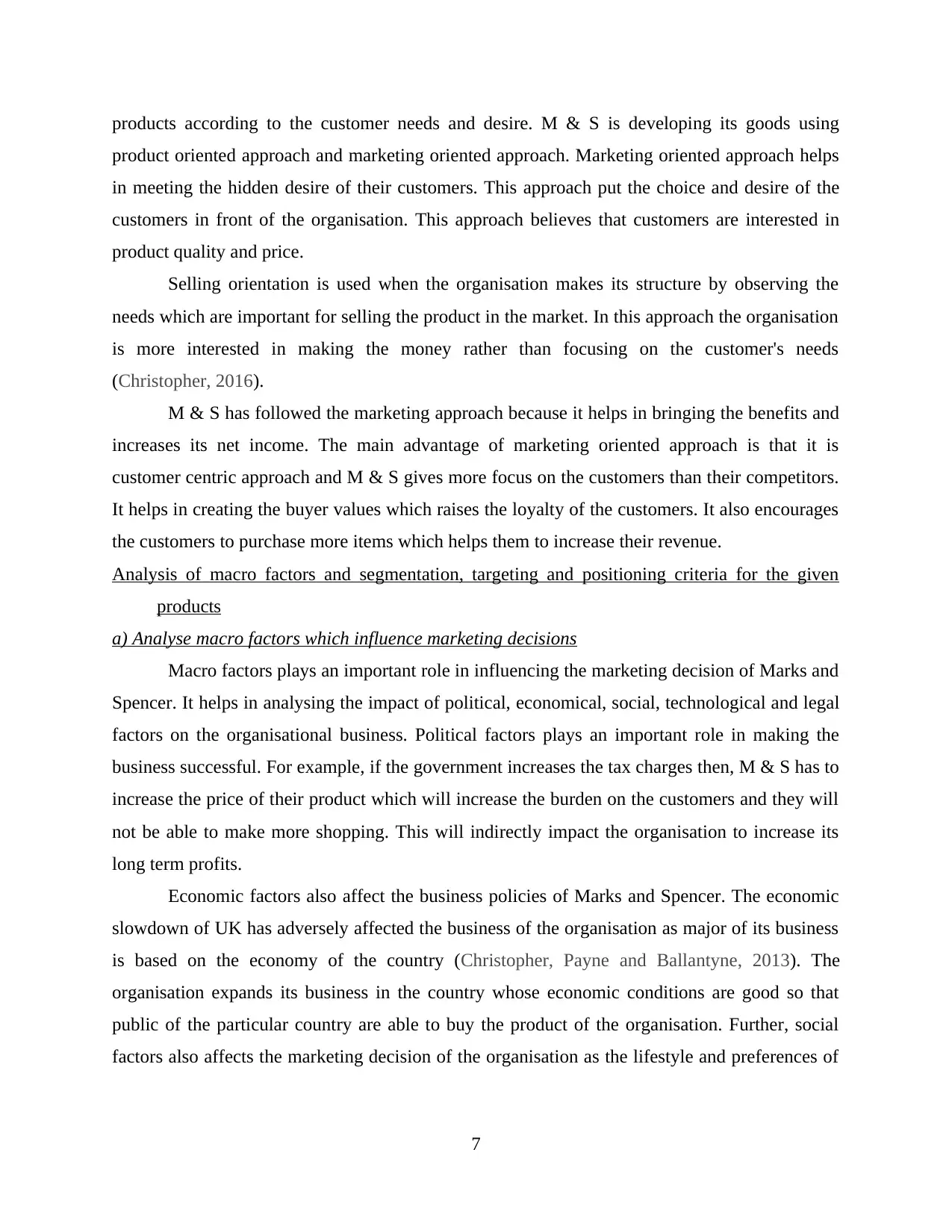
products according to the customer needs and desire. M & S is developing its goods using
product oriented approach and marketing oriented approach. Marketing oriented approach helps
in meeting the hidden desire of their customers. This approach put the choice and desire of the
customers in front of the organisation. This approach believes that customers are interested in
product quality and price.
Selling orientation is used when the organisation makes its structure by observing the
needs which are important for selling the product in the market. In this approach the organisation
is more interested in making the money rather than focusing on the customer's needs
(Christopher, 2016).
M & S has followed the marketing approach because it helps in bringing the benefits and
increases its net income. The main advantage of marketing oriented approach is that it is
customer centric approach and M & S gives more focus on the customers than their competitors.
It helps in creating the buyer values which raises the loyalty of the customers. It also encourages
the customers to purchase more items which helps them to increase their revenue.
Analysis of macro factors and segmentation, targeting and positioning criteria for the given
products
a) Analyse macro factors which influence marketing decisions
Macro factors plays an important role in influencing the marketing decision of Marks and
Spencer. It helps in analysing the impact of political, economical, social, technological and legal
factors on the organisational business. Political factors plays an important role in making the
business successful. For example, if the government increases the tax charges then, M & S has to
increase the price of their product which will increase the burden on the customers and they will
not be able to make more shopping. This will indirectly impact the organisation to increase its
long term profits.
Economic factors also affect the business policies of Marks and Spencer. The economic
slowdown of UK has adversely affected the business of the organisation as major of its business
is based on the economy of the country (Christopher, Payne and Ballantyne, 2013). The
organisation expands its business in the country whose economic conditions are good so that
public of the particular country are able to buy the product of the organisation. Further, social
factors also affects the marketing decision of the organisation as the lifestyle and preferences of
7
product oriented approach and marketing oriented approach. Marketing oriented approach helps
in meeting the hidden desire of their customers. This approach put the choice and desire of the
customers in front of the organisation. This approach believes that customers are interested in
product quality and price.
Selling orientation is used when the organisation makes its structure by observing the
needs which are important for selling the product in the market. In this approach the organisation
is more interested in making the money rather than focusing on the customer's needs
(Christopher, 2016).
M & S has followed the marketing approach because it helps in bringing the benefits and
increases its net income. The main advantage of marketing oriented approach is that it is
customer centric approach and M & S gives more focus on the customers than their competitors.
It helps in creating the buyer values which raises the loyalty of the customers. It also encourages
the customers to purchase more items which helps them to increase their revenue.
Analysis of macro factors and segmentation, targeting and positioning criteria for the given
products
a) Analyse macro factors which influence marketing decisions
Macro factors plays an important role in influencing the marketing decision of Marks and
Spencer. It helps in analysing the impact of political, economical, social, technological and legal
factors on the organisational business. Political factors plays an important role in making the
business successful. For example, if the government increases the tax charges then, M & S has to
increase the price of their product which will increase the burden on the customers and they will
not be able to make more shopping. This will indirectly impact the organisation to increase its
long term profits.
Economic factors also affect the business policies of Marks and Spencer. The economic
slowdown of UK has adversely affected the business of the organisation as major of its business
is based on the economy of the country (Christopher, Payne and Ballantyne, 2013). The
organisation expands its business in the country whose economic conditions are good so that
public of the particular country are able to buy the product of the organisation. Further, social
factors also affects the marketing decision of the organisation as the lifestyle and preferences of
7
⊘ This is a preview!⊘
Do you want full access?
Subscribe today to unlock all pages.

Trusted by 1+ million students worldwide
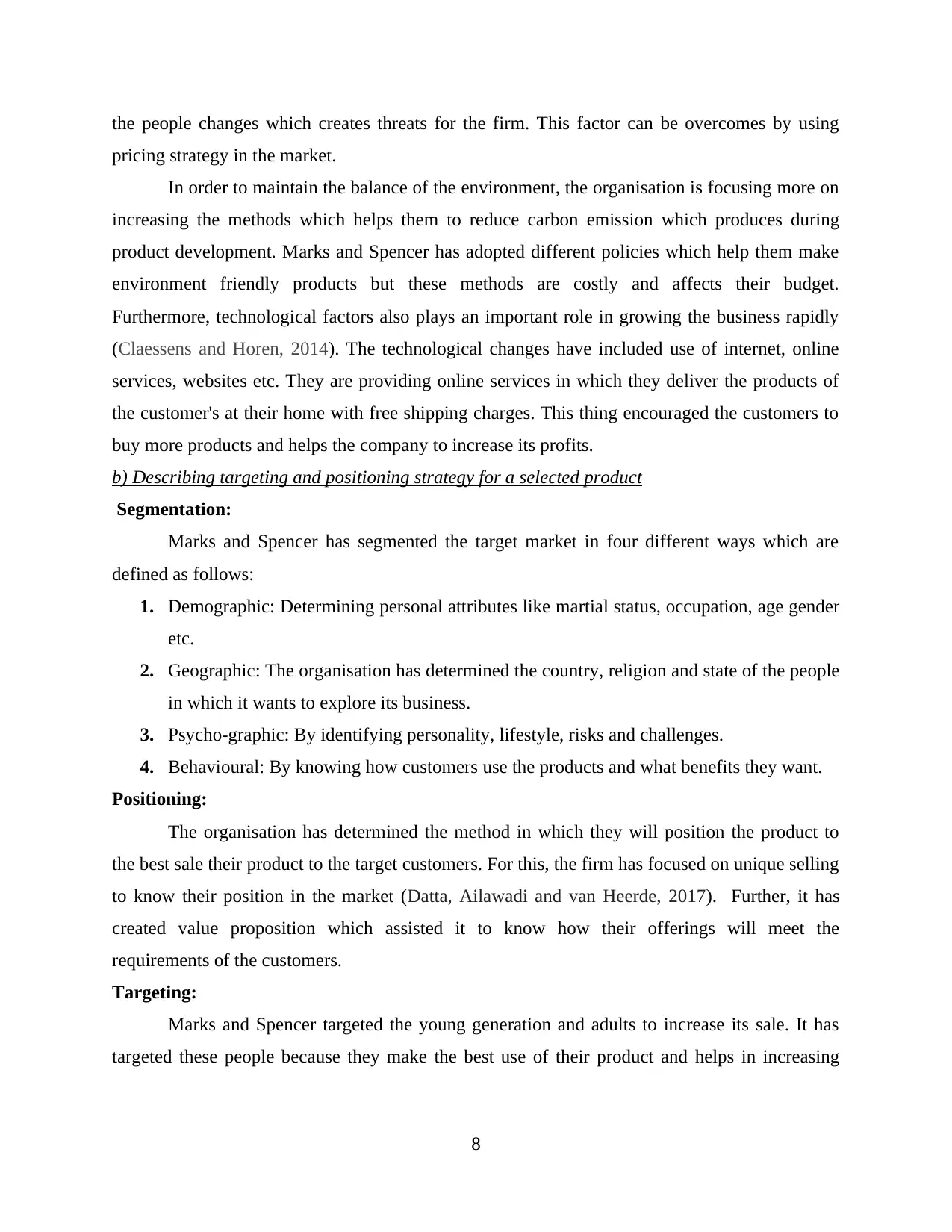
the people changes which creates threats for the firm. This factor can be overcomes by using
pricing strategy in the market.
In order to maintain the balance of the environment, the organisation is focusing more on
increasing the methods which helps them to reduce carbon emission which produces during
product development. Marks and Spencer has adopted different policies which help them make
environment friendly products but these methods are costly and affects their budget.
Furthermore, technological factors also plays an important role in growing the business rapidly
(Claessens and Horen, 2014). The technological changes have included use of internet, online
services, websites etc. They are providing online services in which they deliver the products of
the customer's at their home with free shipping charges. This thing encouraged the customers to
buy more products and helps the company to increase its profits.
b) Describing targeting and positioning strategy for a selected product
Segmentation:
Marks and Spencer has segmented the target market in four different ways which are
defined as follows:
1. Demographic: Determining personal attributes like martial status, occupation, age gender
etc.
2. Geographic: The organisation has determined the country, religion and state of the people
in which it wants to explore its business.
3. Psycho-graphic: By identifying personality, lifestyle, risks and challenges.
4. Behavioural: By knowing how customers use the products and what benefits they want.
Positioning:
The organisation has determined the method in which they will position the product to
the best sale their product to the target customers. For this, the firm has focused on unique selling
to know their position in the market (Datta, Ailawadi and van Heerde, 2017). Further, it has
created value proposition which assisted it to know how their offerings will meet the
requirements of the customers.
Targeting:
Marks and Spencer targeted the young generation and adults to increase its sale. It has
targeted these people because they make the best use of their product and helps in increasing
8
pricing strategy in the market.
In order to maintain the balance of the environment, the organisation is focusing more on
increasing the methods which helps them to reduce carbon emission which produces during
product development. Marks and Spencer has adopted different policies which help them make
environment friendly products but these methods are costly and affects their budget.
Furthermore, technological factors also plays an important role in growing the business rapidly
(Claessens and Horen, 2014). The technological changes have included use of internet, online
services, websites etc. They are providing online services in which they deliver the products of
the customer's at their home with free shipping charges. This thing encouraged the customers to
buy more products and helps the company to increase its profits.
b) Describing targeting and positioning strategy for a selected product
Segmentation:
Marks and Spencer has segmented the target market in four different ways which are
defined as follows:
1. Demographic: Determining personal attributes like martial status, occupation, age gender
etc.
2. Geographic: The organisation has determined the country, religion and state of the people
in which it wants to explore its business.
3. Psycho-graphic: By identifying personality, lifestyle, risks and challenges.
4. Behavioural: By knowing how customers use the products and what benefits they want.
Positioning:
The organisation has determined the method in which they will position the product to
the best sale their product to the target customers. For this, the firm has focused on unique selling
to know their position in the market (Datta, Ailawadi and van Heerde, 2017). Further, it has
created value proposition which assisted it to know how their offerings will meet the
requirements of the customers.
Targeting:
Marks and Spencer targeted the young generation and adults to increase its sale. It has
targeted these people because they make the best use of their product and helps in increasing
8
Paraphrase This Document
Need a fresh take? Get an instant paraphrase of this document with our AI Paraphraser
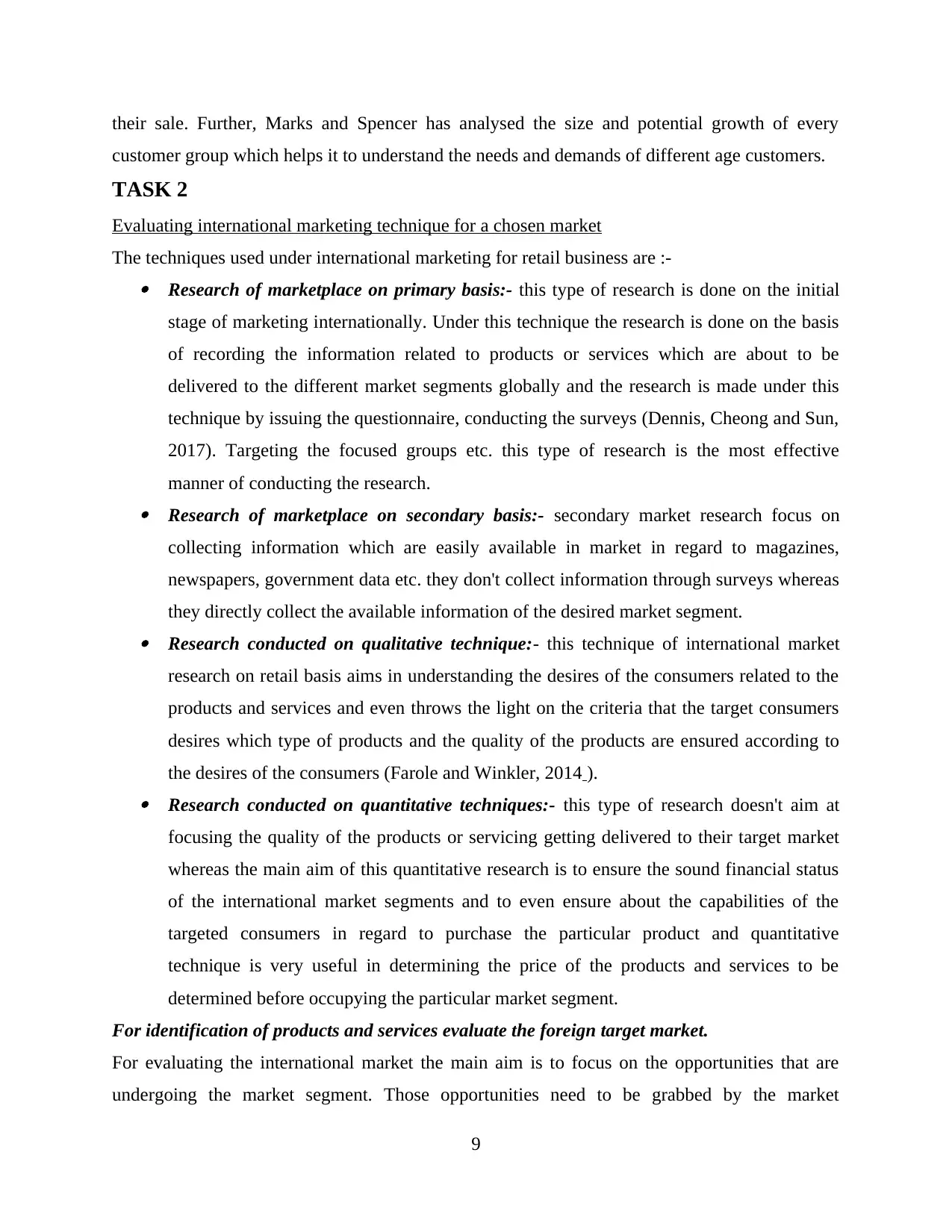
their sale. Further, Marks and Spencer has analysed the size and potential growth of every
customer group which helps it to understand the needs and demands of different age customers.
TASK 2
Evaluating international marketing technique for a chosen market
The techniques used under international marketing for retail business are :- Research of marketplace on primary basis:- this type of research is done on the initial
stage of marketing internationally. Under this technique the research is done on the basis
of recording the information related to products or services which are about to be
delivered to the different market segments globally and the research is made under this
technique by issuing the questionnaire, conducting the surveys (Dennis, Cheong and Sun,
2017). Targeting the focused groups etc. this type of research is the most effective
manner of conducting the research. Research of marketplace on secondary basis:- secondary market research focus on
collecting information which are easily available in market in regard to magazines,
newspapers, government data etc. they don't collect information through surveys whereas
they directly collect the available information of the desired market segment. Research conducted on qualitative technique:- this technique of international market
research on retail basis aims in understanding the desires of the consumers related to the
products and services and even throws the light on the criteria that the target consumers
desires which type of products and the quality of the products are ensured according to
the desires of the consumers (Farole and Winkler, 2014 ). Research conducted on quantitative techniques:- this type of research doesn't aim at
focusing the quality of the products or servicing getting delivered to their target market
whereas the main aim of this quantitative research is to ensure the sound financial status
of the international market segments and to even ensure about the capabilities of the
targeted consumers in regard to purchase the particular product and quantitative
technique is very useful in determining the price of the products and services to be
determined before occupying the particular market segment.
For identification of products and services evaluate the foreign target market.
For evaluating the international market the main aim is to focus on the opportunities that are
undergoing the market segment. Those opportunities need to be grabbed by the market
9
customer group which helps it to understand the needs and demands of different age customers.
TASK 2
Evaluating international marketing technique for a chosen market
The techniques used under international marketing for retail business are :- Research of marketplace on primary basis:- this type of research is done on the initial
stage of marketing internationally. Under this technique the research is done on the basis
of recording the information related to products or services which are about to be
delivered to the different market segments globally and the research is made under this
technique by issuing the questionnaire, conducting the surveys (Dennis, Cheong and Sun,
2017). Targeting the focused groups etc. this type of research is the most effective
manner of conducting the research. Research of marketplace on secondary basis:- secondary market research focus on
collecting information which are easily available in market in regard to magazines,
newspapers, government data etc. they don't collect information through surveys whereas
they directly collect the available information of the desired market segment. Research conducted on qualitative technique:- this technique of international market
research on retail basis aims in understanding the desires of the consumers related to the
products and services and even throws the light on the criteria that the target consumers
desires which type of products and the quality of the products are ensured according to
the desires of the consumers (Farole and Winkler, 2014 ). Research conducted on quantitative techniques:- this type of research doesn't aim at
focusing the quality of the products or servicing getting delivered to their target market
whereas the main aim of this quantitative research is to ensure the sound financial status
of the international market segments and to even ensure about the capabilities of the
targeted consumers in regard to purchase the particular product and quantitative
technique is very useful in determining the price of the products and services to be
determined before occupying the particular market segment.
For identification of products and services evaluate the foreign target market.
For evaluating the international market the main aim is to focus on the opportunities that are
undergoing the market segment. Those opportunities need to be grabbed by the market
9
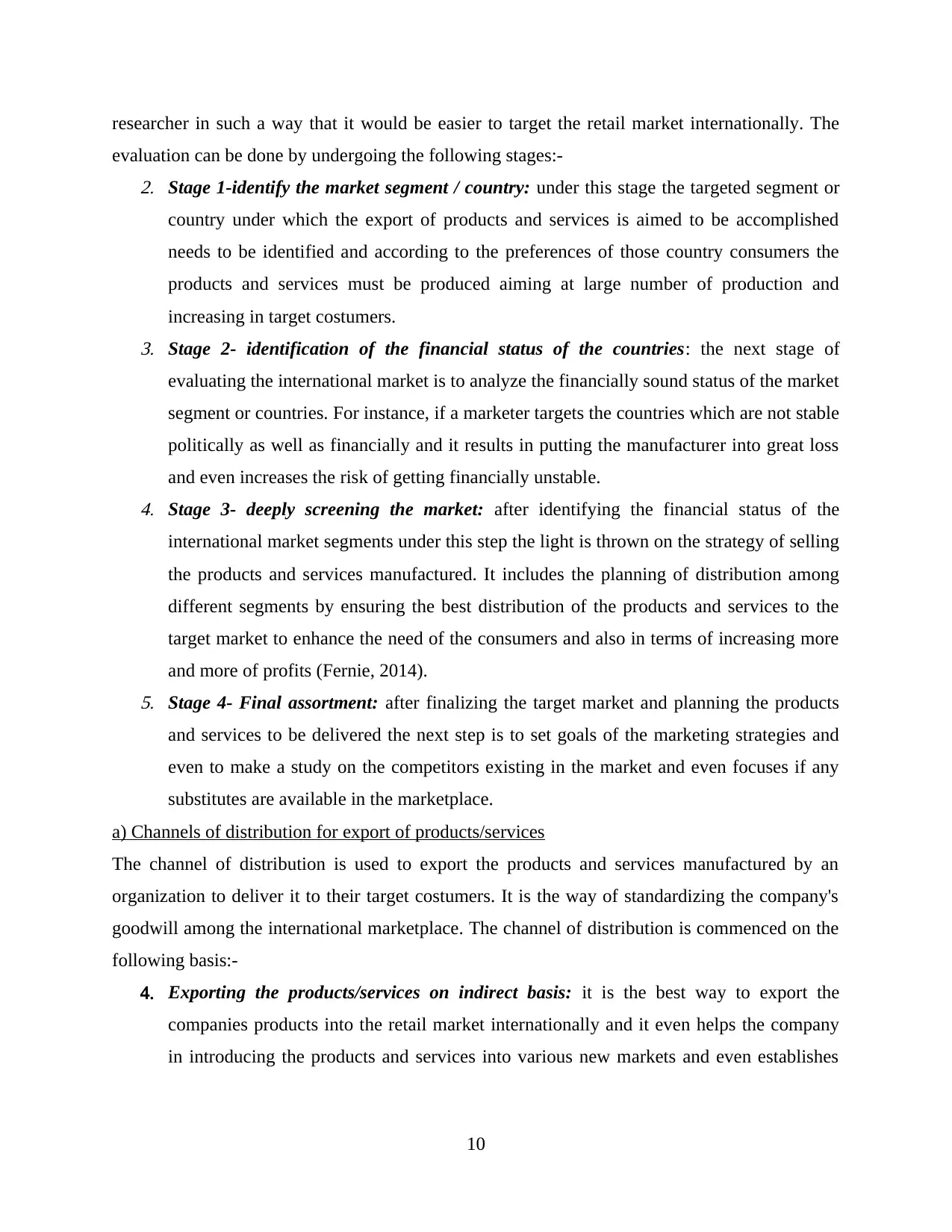
researcher in such a way that it would be easier to target the retail market internationally. The
evaluation can be done by undergoing the following stages:-2. Stage 1-identify the market segment / country: under this stage the targeted segment or
country under which the export of products and services is aimed to be accomplished
needs to be identified and according to the preferences of those country consumers the
products and services must be produced aiming at large number of production and
increasing in target costumers.3. Stage 2- identification of the financial status of the countries: the next stage of
evaluating the international market is to analyze the financially sound status of the market
segment or countries. For instance, if a marketer targets the countries which are not stable
politically as well as financially and it results in putting the manufacturer into great loss
and even increases the risk of getting financially unstable.4. Stage 3- deeply screening the market: after identifying the financial status of the
international market segments under this step the light is thrown on the strategy of selling
the products and services manufactured. It includes the planning of distribution among
different segments by ensuring the best distribution of the products and services to the
target market to enhance the need of the consumers and also in terms of increasing more
and more of profits (Fernie, 2014).5. Stage 4- Final assortment: after finalizing the target market and planning the products
and services to be delivered the next step is to set goals of the marketing strategies and
even to make a study on the competitors existing in the market and even focuses if any
substitutes are available in the marketplace.
a) Channels of distribution for export of products/services
The channel of distribution is used to export the products and services manufactured by an
organization to deliver it to their target costumers. It is the way of standardizing the company's
goodwill among the international marketplace. The channel of distribution is commenced on the
following basis:-
4. Exporting the products/services on indirect basis: it is the best way to export the
companies products into the retail market internationally and it even helps the company
in introducing the products and services into various new markets and even establishes
10
evaluation can be done by undergoing the following stages:-2. Stage 1-identify the market segment / country: under this stage the targeted segment or
country under which the export of products and services is aimed to be accomplished
needs to be identified and according to the preferences of those country consumers the
products and services must be produced aiming at large number of production and
increasing in target costumers.3. Stage 2- identification of the financial status of the countries: the next stage of
evaluating the international market is to analyze the financially sound status of the market
segment or countries. For instance, if a marketer targets the countries which are not stable
politically as well as financially and it results in putting the manufacturer into great loss
and even increases the risk of getting financially unstable.4. Stage 3- deeply screening the market: after identifying the financial status of the
international market segments under this step the light is thrown on the strategy of selling
the products and services manufactured. It includes the planning of distribution among
different segments by ensuring the best distribution of the products and services to the
target market to enhance the need of the consumers and also in terms of increasing more
and more of profits (Fernie, 2014).5. Stage 4- Final assortment: after finalizing the target market and planning the products
and services to be delivered the next step is to set goals of the marketing strategies and
even to make a study on the competitors existing in the market and even focuses if any
substitutes are available in the marketplace.
a) Channels of distribution for export of products/services
The channel of distribution is used to export the products and services manufactured by an
organization to deliver it to their target costumers. It is the way of standardizing the company's
goodwill among the international marketplace. The channel of distribution is commenced on the
following basis:-
4. Exporting the products/services on indirect basis: it is the best way to export the
companies products into the retail market internationally and it even helps the company
in introducing the products and services into various new markets and even establishes
10
⊘ This is a preview!⊘
Do you want full access?
Subscribe today to unlock all pages.

Trusted by 1+ million students worldwide
1 out of 23
Related Documents
Your All-in-One AI-Powered Toolkit for Academic Success.
+13062052269
info@desklib.com
Available 24*7 on WhatsApp / Email
![[object Object]](/_next/static/media/star-bottom.7253800d.svg)
Unlock your academic potential
Copyright © 2020–2025 A2Z Services. All Rights Reserved. Developed and managed by ZUCOL.





